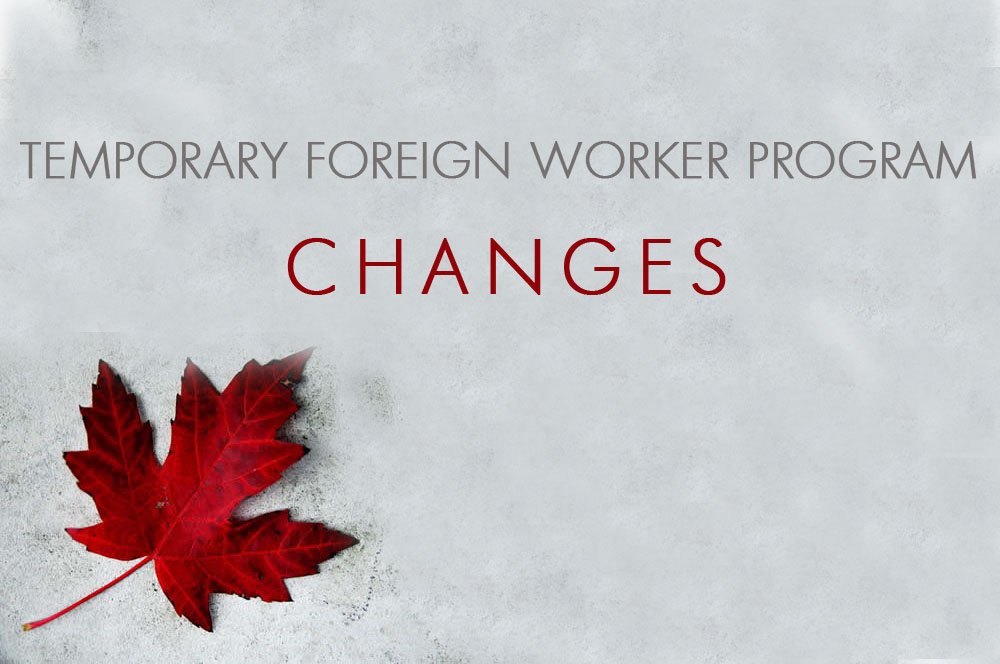 Improving Clarity, Transparency and Accountability of the Temporary Foreign Worker Program
Improving Clarity, Transparency and Accountability of the Temporary Foreign Worker Program
To offer greater clarity and transparency, the Temporary Foreign Worker Program (TFWP) is being re-organized into two distinct programs (TFWP and IMP). This will reduce confusion and better reflect the major differences between the various streams.
On Friday, June 20, 2014 a significant overhaul of the Temporary Foreign Workers Program was announced at a lengthy media conference with both Minister of Employment and Social Development Jason Kenney and CIC Minister Chris Alexander presiding.
Background to Changes
The Ministers’ announcements come after what has been a long and grueling controversy surrounding the Program and its administration. In particular, there have been noted employers in the news as of late whose employment practices have been called into question. Stories of replacing Canadian workers with temporary foreign workers to employer abuses in terms of promises of wages and accommodation for their foreign workers have plagued the evening news.
With the new changes that have been made, the Government hopes to strike the right balance between ensuring that the TFWP is flexible enough to respond to Canada’s labour shortages while also protecting the rights of both temporary foreign workers and Canadian citizens.
TFWP Going Forward
The TFWP will now refer to only those streams under which foreign workers enter Canada at the request of employers following approval through a new Labour Market Impact Assessment (LMIA). The new International Mobility Programs (IMP) will include those streams in which foreign nationals are not subject to an LMIA, and whose primary objective is to advance Canada’s broad economic and cultural national interest, rather than filling particular jobs. These new categories will improve accountability, with Employment and Social Development Canada being the lead department for the TFWP, and Citizenship and Immigration Canada the lead department for the IMP.
|
Temporary Foreign Worker Program Objective:
Last resort for employers to fill jobs for which qualified Canadians are not available
|
International Mobility Programs Objective:
To advance Canada’s broad economic and cultural national interest
|
|
Based on employer demand to fill specific jobs
|
Not based on employer demand
|
|
Unilateral and discretionary
|
Base largely on multilateral/bilateral agreements with other countries (e.g. NAFTA, GATS)
|
|
Employer must pass Labour Market Impact Assessment (formerly LMO)
|
No Labour Market Impact Assessment required
|
|
Lead department ESDC
|
Lead department CIC
|
|
No reciprocity
|
Based largely on reciprocity
|
|
Employer-specific work permits (TFWs tied to one employer)
|
Generally open permits (participants have greater mobility)
|
|
Majority are low-skilled (e.g. farm workers)
|
Majority are high skill / high wage
|
|
Last and limited resort because no Canadians are available
|
Workers & reciprocity are deemed to be in the national economic and cultural interest
|
|
Main source countries are developing countries
|
Main source countries are highly developed
|
In the interest of greater transparency and accountability, data for the TFWP and IMP have been re-organized so that statistics on the two distinct programs can be accurately tracked going back 10 years. Of the 221,273 foreign nationals entering Canada in 2013, 62 percent (137,533) came in under the IMP, the other 38 percent, or (83,740), came in under the TFWP.
Using Wage Instead of National Occupation Codes
The Temporary Foreign Worker Program (TFWP) will now be administered based on wage instead of the National Occupational Classification (NOC). The Government has found that Wage is a more objective and accurate reflection of skill level and labour need in a given area. Temporary foreign workers being paid under the provincial/territorial median wage will be considered low-wage, while those being paid at or above will be considered high-wage.
Median Hourly Wages by Province/Territory
|
Province/Territory
|
Wage ($/hr)
|
|
Newfoundland and Labrador
|
$ 20.19
|
|
Prince Edward Island
|
$ 17.26
|
|
Nova Scotia
|
$ 18.00
|
|
New Brunswick
|
$ 17.79
|
|
Quebec
|
$ 20.00
|
|
Ontario
|
$ 21.00
|
|
Manitoba
|
$ 19.00
|
|
Saskatchewan
|
$ 21.63
|
|
Alberta
|
$ 24.23
|
|
British Columbia
|
$ 21.79
|
|
Yukon
|
$ 27.93
|
|
Northwest Territories
|
$ 32.53
|
|
Nunavut
|
$ 29.96
|
Source: Labour Force Survey, 2013
The primary categories under the new TFWP
Under the new TFWP, there will be a priority focus on the following occupational streams:
High-wage:positions at or above the provincial/territorial median wage; examples of high-wage occupations include managerial, scientific, professional and technical positions as well as the skilled trades.
Low-wage:positions below the provincial/territorial median wage; examples of low-wage occupations include general labourers, food counter attendants, and sales and service personnel.
Primary Agricultural Stream: includes positions related to on-farm primary agriculture such as general farm workers, nursery and greenhouse workers, feed lot workers and harvesting labourers, including under the Seasonal Agricultural Workers Program, which enables the entry of foreign workers from Mexico and a number of Caribbean countries to meet the temporary, seasonal needs of agricultural producers.
Highest-demand, highest-paid or shortest-duration: Labour Market Impact Assessments for in-demand occupations (skilled trades), highly paid occupations (top 10%) or short-duration (120 days or less) entries will be provided within a 10 business day service standard. As for all requests to hire temporary foreign workers, LMIAs would only be granted after a rigorous review of all of the elements of the employer’s application in each of these cases.
Live-in Caregiver Program: no change.
New Labour Market Impact Assessment (LMIA) Snapshot
The labour market test that allows employers to bring temporary foreign workers to Canada is being transformed from a Labour Market Opinion (LMO) to a new Labour Market Impact Assessment (LMIA), a process that is more comprehensive and rigorous. Employers must provide additional information, including the number of Canadians that applied for their available job, the number of Canadians the employer interviewed, and explain why those Canadians were not hired. Employers must now also attest they are aware of the rule that Canadians cannot be laid-off or have their hours reduced at a worksite that employs temporary foreign workers.
New and better sources of labour market information will be used to determine if there are Canadians who could fill these positions.
LMIAs are conducted and processed by Employment and Social Development Canada (ESDC). ESDC will refuse to process applications when there are concerns that temporary foreign workers may or will have a significant negative effect on the Canadian labour market.
Current numbers and statistics show that the TFWP is no longer being used as it was intended to be used — as a last and limited resort to allow employers to bring foreign workers to Canada on a temporary basis to fill jobs for which qualified Canadians are not available. The reforms are being implemented to end the growing practice of employers building their business model on access to the TFWP.
Accordingly, the Government of Canada is introducing a cap to limit the proportion of low-wage temporary foreign workers that a business can employ. The cap will significantly restrict access to the TFWP, while ensuring that Canadians are always considered first for available jobs, reducing employer reliance on the program and increasing wages offered to Canadians. It is expected that this measure alone will nearly cut in half the number of low-wage temporary foreign workers once fully implemented.
Employers with 10 or more employees will be subject to a cap of 10 percent on the proportion of their workforce that can consist of low-wage temporary foreign workers. This cap will be applied per worksite of an employer and is based on total hours worked at that worksite. To provide employers time to transition and adjust to this new cap, it will be phased in over the next couple of years.
Effective immediately, employers that are applying for a new LMIA will be limited at 30 percent or frozen at their current level, whichever is lower. This transition measure will be further reduced to 20 percent beginning July 1, 2015 and reduced again to 10 percent on July 1, 2016. The Government may consider lowering the cap further in the future. Temporary foreign workers currently working at work sites over the cap will be allowed to continue working at those sites until their existing work permits expire.
The caps will ensures that large employers with multiple locations cannot be over their limit for low-wage temporary foreign workers at any one of their locations. For example, a large employer with an overall national workforce comprised of 5 percent temporary foreign workers cannot justify bringing in larger volumes of foreign workers at specific locations and having the temporary foreign worker staff at those locations exceed the cap.
The cap sends an important message—temporary foreign workers cannot be used as a business model and employers must do more to recruit, hire and train Canadians. This measure will help drive down the overall number of low-wage temporary foreign workers in Canada and end the distortion in the labour market caused by their prevalence in some sectors and regions.
Refusing Applications in Areas of High Unemployment
Effective immediately, the Government will begin the process of refusal of certain Labour Market Impact Assessment applications in the Accommodation, Food Services and Retail Trade sectors. Specifically, any applications for positions that require little or no education or training will not be processed in economic regions with an unemployment rate at or above 6%.
Reducing the Duration of Work Permits set out in Labour Market Impact Assessments
Effective immediately, the duration of work permits set out in Labour Market Impact Assessments (LMIAs) will be limited to a maximum of one year for all low-wage positions, rather than the 2 year duration that existed previously. Employers of low-wage temporary foreign workers must reapply every year for an LMIA, better-accommodating for changes in labour market conditions that might have occurred.
Reducing the Length of Time a Temporary Foreign Worker can Work in Canada
The TFWP is to be used as a last and limited resort, and to encourage employers to make even greater efforts to ensure foreign workers are coming in on a truly temporary basis and that Employers are encouraged to hire and train Canadian workers before seeking temporary foreign workers. In order to facilitate this transition, the Government will reduce how long a temporary foreign worker in the low-wage stream can work in Canada. This measure will not apply to temporary foreign workers currently in Canada on valid work permits.
Changing the Provincial/Territorial Temporary Foreign Worker Annexes
Five provincial/territorial governments (Alberta, British Columbia, Ontario, Nova Scotia and Yukon) currently have annexes to their immigration agreements with the Government that establish Labour Market Impact Assessment (LMIA) exemptions in their jurisdiction. In these cases, the provinces and territories may propose LMIA exemptions for certain occupations and pilot projects involving exemptions to the LMIA process can be initiated.
Transition Plans for High-Wage Positions
Employers who want to hire temporary foreign workers in high-wage occupations will be required (with limited exceptions) to submit transition plans with their Labour Market Impact Assessment (LMIA) application to ensure that they are taking steps to reduce their reliance on temporary foreign workers over time. This underscores the purpose of the program — which is to operate as a last and limited resort to address immediate labour needs on a temporary basis when qualified Canadians are not available.
Highest-Demand, Highest-Paid and Shortest-Duration Occupations
LMIAs for highest-demand occupations (skilled trades), highest-paid (top 10 percent) occupations or short-duration work periods (120 days or less) will now be provided within a 10-business-day service standard. As is the case for all requests to hire temporary foreign workers, LMIAs would only be granted after a rigorous review of all of the elements of the employer’s application in each of these cases. This service standard will be met by processing these applications first, not by reducing the thoroughness of these LMIAs.
Labour Market Impact Assessment Fee of $1,000
As with the proposed changes and the more rigorous measures to be implemented in the new Temporary Foreign Worker Program (TFWP), this will substantially increase the cost of delivering the program. The costs for administering the TFWP, including all of the reforms outlined above, will be borne entirely by employers who use the program, and not by Canadian citizens and tax payers. As a result, the LMIA fee is increasing from $275 to $1,000 for every temporary foreign worker position requested by an employer.
The following chart illustrates the increase of the fee over the past few years:
|
Year
|
Assessment Fee
|
|
1973 – 2013
|
$0
|
|
July 2013
|
$275
|
|
June 2014
|
$1,000
|
The fee will be evaluated on an ongoing basis, and necessary adjustments will be made to ensure that it continues to fully cover the costs of the TFWP.
Additionally, the Ministry of Employment and Social Development will be seeking the authority to impose an estimated $100 privilege fee on employers applying for LMIAs to offset the costs of Government of Canada investments in skills and job training.
Better and More Labour Market Information
The new Labour Market Impact Assessment will be made more effective with the introduction of more and better labour market information. As part of this structure, a new enhanced Job Matching Service will allow Canadians to apply directly through the Canada Job Bank for jobs that match their skills and experience. As employers applying for temporary foreign workers must post their jobs on the Job Bank website, the new Job Matching Service will be able to match unemployed Canadians with employers offering available jobs that match their skills in their region. Furthermore, program officers will be better aware of the number of potential applicants and how closely their skills align with the available job, which will allow for more rigorous assessment of LMIA applications.
Increasing the Number and Scope of Inspections
Given concerns over abuse of the Temporary Foreign Worker Program (TFWP), the Government is making a significant investment in its TFWP inspection regime.
Beginning in fall 2014, the Government will impose fines of up to $100,000 (depending on the severity of the offence) on employers who break the rules of the Temporary Foreign Worker Program (TFWP). As part of the Government’s efforts to improve the transparency and accountability of the TFWP, the Government will publicly disclose the names of employers who have been fined and the amount of that fine on the Blacklist.
In Conclusion
The changes to the TFWP serve to increase the commitment of the Canadian employer to train an already available Canadian labour force while resorting to a smaller avenue where they could hire a temporary foreign worker as a last resort, if needed, after all other avenues have been exhausted.
Employers will see that the system is set up still to facilitate a foreign worker immigration process, should it be the genuine requirement of their business. As well, there are many other streams for immigration that are available to the Employer should the TFWP not fit with their hiring goals. There still remains within the system great flexibility within the current immigration program offerings across Canada.




